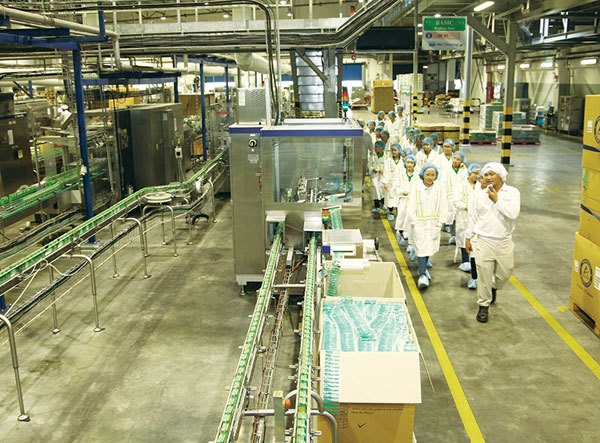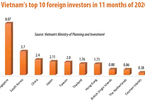But how might current unrest in other Southeast Asian countries affect the flows of investment in the region as it simultaneously attempts to fight its way out of the pandemic?
 |
| When pondering investment in Southeast Asia, labour wages sit alongside political stability as key factors. Photo: Le Toan/VIR |
While it may sometimes feel that the coronavirus pandemic is the only headline news on a global level these days, other serious issues are beginning to garner more notice as countries try to fight their way out of the health crisis.
Of interest to some businesspeople and enterprises with activities or potential development plans in 2021 is the ongoing unrest in Asia – in particular, in destinations such as Thailand, Myanmar, and Cambodia, along with newly-enacted changes in the likes of Hong Kong last year.
Experts are now beginning to pore over available data and ponder whether some nations and territories will see an exodus of investors, especially big multinationals – and if so, seek to predict where they will go.
On the other side of the coin, as these markets face uncertainty, others are attempting to either open up to more investment or proclaim that finances are already on the right track after emerging from the global health crisis – adding to signs that funding shifts are taking place for a new era.
Nikkei Asia reported on March 11 that the Philippines is closer to loosening its strict rules on foreign direct investment (FDI), previously seen as stifling international companies looking to carve a piece of a Southeast Asian market dominated by local conglomerates.
With just over a year left in office, President Rodrigo Duterte is reportedly making a last push for greater openness to foreign investment, with the changes attempting to undo what a 2019 Organization for Economic Cooperation and Development index said was the continents’ most restrictive FDI rules.
On the same day, Chinese cable news network CGTN noted that FDI flows to China rose by 34.2 per cent on-year to $26.07 billion in January and February (excluding banking, securities, and insurance), as per data from its Ministry of Commerce.
In terms of source, funding from ASEAN countries and from the Belt and Road Initiative increased by 28.1 and 26.2 per cent, respectively, while investment from the European Union raised by 31.5 per cent on-year.
As the first to suffer from COVID-19 and, subsequently, one of the first to experience life without it, China has been looking to capitalise by widening market access for foreign investment, further reducing the number of sectors and industries off-limits to both Chinese and overseas investors from January.
Regional shifts
When it comes to businesses with an eye on the continent and in Southeast Asia in particular, a wait-and-see approach may be the only option. According to Brigitta Kinadi and Andrew Yeo, senior associates at strategic advisory group Global Counsel, there are three themes to watch out for this year when it comes to shifts that may have implications for both corporate and investors.
Firstly, tensions may continue to escalate in a number of places, of which Myanmar stands out. “The political crisis in Myanmar is deteriorating, and while the response of foreign businesses and investors has been fairly muted so far, much will depend on future sanctions that will likely be imposed,” they wrote.
A second major theme will be the continuing demands of Beijing for regional pre-eminence. “Member states of ASEAN are now well attuned to the growing role China seeks, and external trade and investment will still be prioritised as the ruling party marks its 100th anniversary,” the senior associates added.
Lastly, the new US administration is being greeted with calm. “While it is unclear how a Biden administration plans to engage with the region, the escalating political and public health crisis he inherits means domestic needs are likely to take priority,” Kinadi and Yeo concluded.
For Vietnam, many observers are paying attention to events in Thailand, which has traditionally competed with Vietnam across many sectors and fields.
Maxwell Abbott, head of Business Intelligence in Asia for Risk Advisory Group, noted that much of Thailand’s recent economic woes are mostly due to the pandemic, as a country that depended on tourism for nearly 15 per cent of its GDP. But political conflicts that erupted last year and resumed despite pandemic restrictions in January are also affecting confidence of investors.
“As the standoff drags on, the initial shock seems to have worn off and there are signs of Thailand regaining its status as a destination for FDI,” Abbott explained. “That said, the current movement exposes Thailand’s systemic instability, something which could be a deterrent to foreign investors in the years and decades to come.”
Alicia Garcia-Herrero, chief economist for Asia-Pacific at French investment bank Natixis, had already summarised the situation back in November when she stated that “higher political risk is weighing negatively on investment” from both foreign and domestic sources.
According to the Financial Times, about $7.8 billion flowed out of Thai stocks last year up to the end of August, and another $2.3 billion out of bonds. It also noted that stocks had dropped more than 20 per cent to that point of the year, with dwindling investment also evident in specific sectors, especially renewable energy.
But confidence always seems to return. In November, overseas investors became net buyers on the Thai stock market for the first time all year. And an independent study in December revealed that 96 per cent of foreign investors operating in Thailand had plans to increase or maintain their presence in the country.
The best offer
But even if Thailand can weather the current storm, economists said it is not unreasonable to ask why financiers would continue to endure the country’s repeated episodes of unrest, especially when neighbouring Southeast Asian countries – particularly Vietnam and Indonesia – offer political stability and attractive investment incentives.
Gareth Leather, senior Asia economist at London-based consultancy Capital Economics told The Diplomat, “If you’re an investor looking to establish a factory in Southeast Asia, you look at Vietnam – it’s politically stable, has low wages, and borders
China. And then you look at Thailand – which has slightly higher wages, maybe doesn’t have the same infrastructure links to China, and sees periodic bouts of quite severe unrest. It’s a no-brainer.”
If Thailand wants to remain competitive with Vietnam, Indonesia, and the other emerging economies of the region, according to Abbott from Risk Advisory Group, it will need to find a sustainable resolution to the current movement that prevent the same issues cropping up just a few years down the line.
Indeed, lessons can be learned in Vietnam from events elsewhere, but it also involves a lot of hard work in order to ensure companies will still eye Vietnam at the top of the list when it comes to the promised lands of ASEAN.
Le Hong Hiep, fellow in both the Vietnam Studies Program and the Regional Strategic and Political Studies Program at the
ISEAS-Yusof Ishak Institute in Singapore, said that Vietnam needs to seize the chance now to leap into the post-pandemic era, full steam ahead. “The challenge is for Vietnam to quickly upgrade infrastructure and the workforce to meet the increasing demands, and to deal with certain unintended consequences, such as the country’s increasing dependence on foreign investment and exports,” Hiep said.
“Vietnamese leaders believe that political stability is a precondition for economic development, and of course it would be right to not attempt to destabilise the current system – besides, their conviction is further strengthened by recent developments in the region, especially in Myanmar,” he added.
Other experts believed that regional unrest is not the be-all and end-all when it comes to making a mark through investments.
Jonathan Sanchez, Diageo’s director of corporate relations in Southeast Asia, told Marketing Interactive that businesses looking to invest in countries undergoing unrest, interruption, or controversy are most often going to take a very long lens view.
“Mid- to long-term assessments are generally made on the premise of the business offer and route to market: how secure is the consumer? Is consumption growing? Can the economy be maintained? How is this affecting the supply or value chain? That is what matters,” Sanchez said.
According to Sanchez, should businesses want to succeed in Southeast Asia, they need to be acutely mindful of the pace of change, unpredictability, and ambiguity. “In return, however, there are endless opportunities, a bias for growth and optimism, and the ability to move at pace,” he insisted.
However, he added that if investors can navigate sometimes bumpy social and economic environments, they can truly succeed. “There has never been a better time to become an entrepreneur, start a business or follow your ambition, in any part of this phenomenal region,” Sanchez explained.
VIR

Special moment for Vietnam: time to rise as opportunities open up
As the global production network has been seriously disrupted, now is the time for Vietnam to reposition itself in the supply chain.

World’s largest trade accord heightens interest in Vietnam
With the advantages to enlarge investment space, the Regional Comprehensive Economic Partnership is expected to add opportunities for Vietnam’s foreign funding inflows on the back of new motivations and trends.